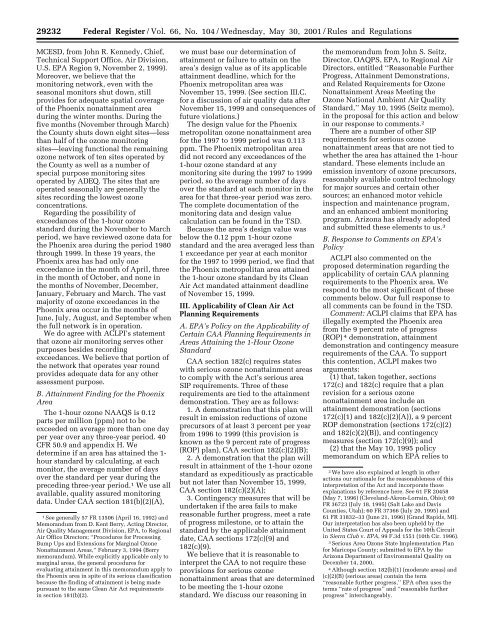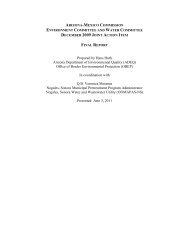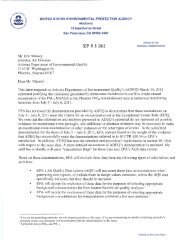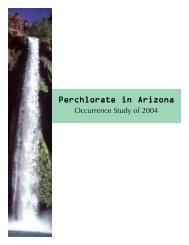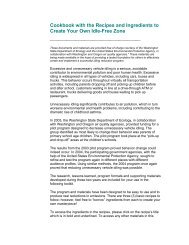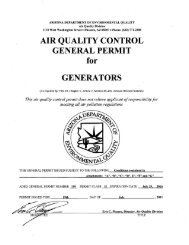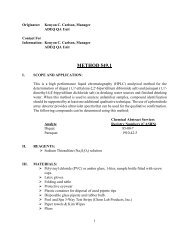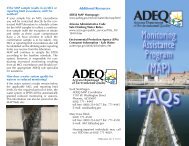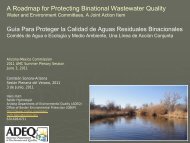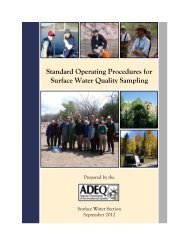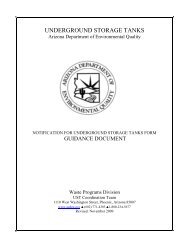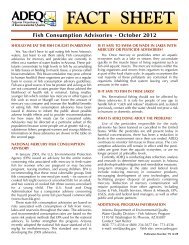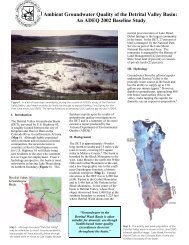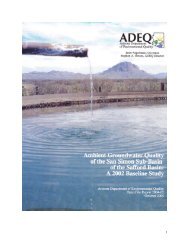66 FR 29230 - Determination of Attainment of the - U.S. Government ...
66 FR 29230 - Determination of Attainment of the - U.S. Government ...
66 FR 29230 - Determination of Attainment of the - U.S. Government ...
- No tags were found...
Create successful ePaper yourself
Turn your PDF publications into a flip-book with our unique Google optimized e-Paper software.
29232 Federal Register / Vol. <strong>66</strong>, No. 104 / Wednesday, May 30, 2001 / Rules and RegulationsMCESD, from John R. Kennedy, Chief,Technical Support Office, Air Division,U.S. EPA Region 9, November 2, 1999).Moreover, we believe that <strong>the</strong>monitoring network, even with <strong>the</strong>seasonal monitors shut down, stillprovides for adequate spatial coverage<strong>of</strong> <strong>the</strong> Phoenix nonattainment areaduring <strong>the</strong> winter months. During <strong>the</strong>five months (November through March)<strong>the</strong> County shuts down eight sites—lessthan half <strong>of</strong> <strong>the</strong> ozone monitoringsites—leaving functional <strong>the</strong> remainingozone network <strong>of</strong> ten sites operated by<strong>the</strong> County as well as a number <strong>of</strong>special purpose monitoring sitesoperated by ADEQ. The sites that areoperated seasonally are generally <strong>the</strong>sites recording <strong>the</strong> lowest ozoneconcentrations.Regarding <strong>the</strong> possibility <strong>of</strong>exceedances <strong>of</strong> <strong>the</strong> 1-hour ozonestandard during <strong>the</strong> November to Marchperiod, we have reviewed ozone data for<strong>the</strong> Phoenix area during <strong>the</strong> period 1980through 1999. In <strong>the</strong>se 19 years, <strong>the</strong>Phoenix area has had only oneexceedance in <strong>the</strong> month <strong>of</strong> April, threein <strong>the</strong> month <strong>of</strong> October, and none in<strong>the</strong> months <strong>of</strong> November, December,January, February and March. The vastmajority <strong>of</strong> ozone exceedances in <strong>the</strong>Phoenix area occur in <strong>the</strong> months <strong>of</strong>June, July, August, and September when<strong>the</strong> full network is in operation.We do agree with ACLPI’s statementthat ozone air monitoring serves o<strong>the</strong>rpurposes besides recordingexceedances. We believe that portion <strong>of</strong><strong>the</strong> network that operates year roundprovides adequate data for any o<strong>the</strong>rassessment purpose.B. <strong>Attainment</strong> Finding for <strong>the</strong> PhoenixAreaThe 1-hour ozone NAAQS is 0.12parts per million (ppm) not to beexceeded on average more than one dayper year over any three-year period. 40C<strong>FR</strong> 50.9 and appendix H. Wedetermine if an area has attained <strong>the</strong> 1-hour standard by calculating, at eachmonitor, <strong>the</strong> average number <strong>of</strong> daysover <strong>the</strong> standard per year during <strong>the</strong>preceding three-year period. 1 We use allavailable, quality assured monitoringdata. Under CAA section 181(b)(2)(A),1 See generally 57 <strong>FR</strong> 13506 (April 16, 1992) andMemorandum from D. Kent Berry, Acting Director,Air Quality Management Division, EPA, to RegionalAir Office Directors; ‘‘Procedures for ProcessingBump Ups and Extensions for Marginal OzoneNonattainment Areas,’’ February 3, 1994 (Berrymemorandum). While explicitly applicable only tomarginal areas, <strong>the</strong> general procedures forevaluating attainment in this memorandum apply to<strong>the</strong> Phoenix area in spite <strong>of</strong> its serious classificationbecause <strong>the</strong> finding <strong>of</strong> attainment is being madepursuant to <strong>the</strong> same Clean Air Act requirementsin section 181(b)(2).we must base our determination <strong>of</strong>attainment or failure to attain on <strong>the</strong>area’s design value as <strong>of</strong> its applicableattainment deadline, which for <strong>the</strong>Phoenix metropolitan area wasNovember 15, 1999. (See section III.C.for a discussion <strong>of</strong> air quality data afterNovember 15, 1999 and consequences <strong>of</strong>future violations.)The design value for <strong>the</strong> Phoenixmetropolitan ozone nonattainment areafor <strong>the</strong> 1997 to 1999 period was 0.113ppm. The Phoenix metropolitan areadid not record any exceedances <strong>of</strong> <strong>the</strong>1-hour ozone standard at anymonitoring site during <strong>the</strong> 1997 to 1999period, so <strong>the</strong> average number <strong>of</strong> daysover <strong>the</strong> standard at each monitor in <strong>the</strong>area for that three-year period was zero.The complete documentation <strong>of</strong> <strong>the</strong>monitoring data and design valuecalculation can be found in <strong>the</strong> TSD.Because <strong>the</strong> area’s design value wasbelow <strong>the</strong> 0.12 ppm 1-hour ozonestandard and <strong>the</strong> area averaged less than1 exceedance per year at each monitorfor <strong>the</strong> 1997 to 1999 period, we find that<strong>the</strong> Phoenix metropolitan area attained<strong>the</strong> 1-hour ozone standard by its CleanAir Act mandated attainment deadline<strong>of</strong> November 15, 1999.III. Applicability <strong>of</strong> Clean Air ActPlanning RequirementsA. EPA’s Policy on <strong>the</strong> Applicability <strong>of</strong>Certain CAA Planning Requirements inAreas Attaining <strong>the</strong> 1-Hour OzoneStandardCAA section 182(c) requires stateswith serious ozone nonattainment areasto comply with <strong>the</strong> Act’s serious areaSIP requirements. Three <strong>of</strong> <strong>the</strong>serequirements are tied to <strong>the</strong> attainmentdemonstration. They are as follows:1. A demonstration that this plan willresult in emission reductions <strong>of</strong> ozoneprecursors <strong>of</strong> at least 3 percent per yearfrom 1996 to 1999 (this provision isknown as <strong>the</strong> 9 percent rate <strong>of</strong> progress(ROP) plan), CAA section 182(c)(2)(B);2. A demonstration that <strong>the</strong> plan willresult in attainment <strong>of</strong> <strong>the</strong> 1-hour ozonestandard as expeditiously as practicablebut not later than November 15, 1999,CAA section 182(c)(2)(A);3. Contingency measures that will beundertaken if <strong>the</strong> area fails to makereasonable fur<strong>the</strong>r progress, meet a rate<strong>of</strong> progress milestone, or to attain <strong>the</strong>standard by <strong>the</strong> applicable attainmentdate, CAA sections 172(c)(9) and182(c)(9).We believe that it is reasonable tointerpret <strong>the</strong> CAA to not require <strong>the</strong>seprovisions for serious ozonenonattainment areas that are determinedto be meeting <strong>the</strong> 1-hour ozonestandard. We discuss our reasoning in<strong>the</strong> memorandum from John S. Seitz,Director, OAQPS, EPA, to Regional AirDirectors, entitled ‘‘Reasonable Fur<strong>the</strong>rProgress, <strong>Attainment</strong> Demonstrations,and Related Requirements for OzoneNonattainment Areas Meeting <strong>the</strong>Ozone National Ambient Air QualityStandard,’’ May 10, 1995 (Seitz memo),in <strong>the</strong> proposal for this action and belowin our response to comments. 2There are a number <strong>of</strong> o<strong>the</strong>r SIPrequirements for serious ozonenonattainment areas that are not tied towhe<strong>the</strong>r <strong>the</strong> area has attained <strong>the</strong> 1-hourstandard. These elements include anemission inventory <strong>of</strong> ozone precursors,reasonably available control technologyfor major sources and certain o<strong>the</strong>rsources; an enhanced motor vehicleinspection and maintenance program,and an enhanced ambient monitoringprogram. Arizona has already adoptedand submitted <strong>the</strong>se elements to us. 3B. Response to Comments on EPA’sPolicyACLPI also commented on <strong>the</strong>proposed determination regarding <strong>the</strong>applicability <strong>of</strong> certain CAA planningrequirements to <strong>the</strong> Phoenix area. Werespond to <strong>the</strong> most significant <strong>of</strong> <strong>the</strong>secomments below. Our full response toall comments can be found in <strong>the</strong> TSD.Comment: ACLPI claims that EPA hasillegally exempted <strong>the</strong> Phoenix areafrom <strong>the</strong> 9 percent rate <strong>of</strong> progress(ROP) 4 demonstration, attainmentdemonstration and contingency measurerequirements <strong>of</strong> <strong>the</strong> CAA. To supportthis contention, ACLPI makes twoarguments:(1) that, taken toge<strong>the</strong>r, sections172(c) and 182(c) require that a planrevision for a serious ozonenonattainment area include anattainment demonstration (sections172(c)(1) and 182(c)(2)(A)), a 9 percentROP demonstration (sections 172(c)(2)and 182(c)(2)(B)), and contingencymeasures (section 172(c)(9)); and(2) that <strong>the</strong> May 10, 1995 policymemorandum on which EPA relies to2 We have also explained at length in o<strong>the</strong>ractions our rationale for <strong>the</strong> reasonableness <strong>of</strong> thisinterpretation <strong>of</strong> <strong>the</strong> Act and incorporate thoseexplanations by reference here. See 61 <strong>FR</strong> 20458(May 7, 1996) (Cleveland-Akron-Lorrain, Ohio); 60<strong>FR</strong> 36723 (July 18, 1995) (Salt Lake and DavisCounties, Utah); 60 <strong>FR</strong> 373<strong>66</strong> (July 20, 1995) and61 <strong>FR</strong> 31832–33 (June 21, 1996) (Grand Rapids, MI).Our interpretation has also been upheld by <strong>the</strong>United States Court <strong>of</strong> Appeals for <strong>the</strong> 10th Circuitin Sierra Club v. EPA, 99 F.3d 1551 (10th Cir. 1996).3 Serious Area Ozone State Implementation Planfor Maricopa County; submitted to EPA by <strong>the</strong>Arizona Department <strong>of</strong> Environmental Quality onDecember 14, 2000,4 Although section 182(b)(1) (moderate areas) and(c)(2)(B) (serious areas) contain <strong>the</strong> term‘‘reasonable fur<strong>the</strong>r progress,’’ EPA <strong>of</strong>ten uses <strong>the</strong>terms ‘‘rate <strong>of</strong> progress’’ and ‘‘reasonable fur<strong>the</strong>rprogress’’ interchangeably.VerDate 112000 14:35 May 29, 2001 Jkt 194001 PO 00000 Frm 00018 Fmt 4700 Sfmt 4700 E:\<strong>FR</strong>\FM\30MYR1.SGM pfrm06 PsN: 30MYR1


